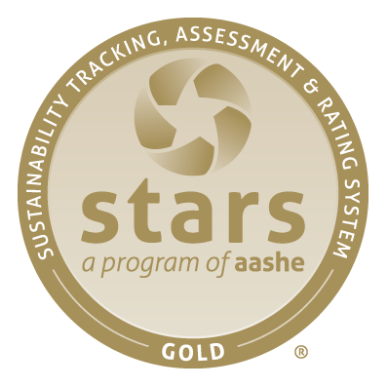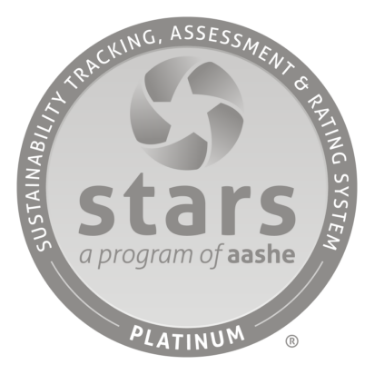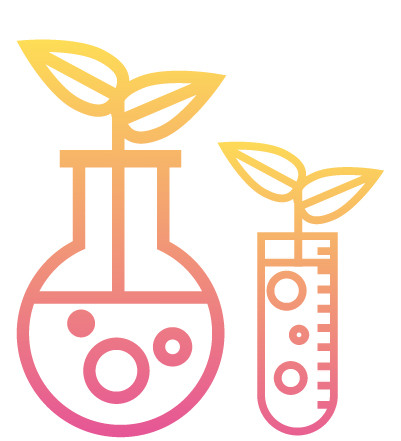Since 2004, UC has been tracking progress in sustainable operations, as required by the UC’s Sustainable Practices Policy.
Summary
As a response to the global coronavirus pandemic, UC campuses shifted to remote learning toward the end of this reporting period, fiscal year 2019-20, in mid-March. In spite of the challenges brought on by the pandemic, UC remains resilient in its commitment to sustainability.
COVID-19 Impacts
The University will likely have a better idea of the impacts of COVID-19 on its sustainability goals after the close of the current fiscal year, 2020-21. However, preliminary analysis shows that:
- Systemwide water use decreased from the previous year, by close to 135,000 gallons, as campuses shifted to remote learning.
- Similarly, campus waste generation also decreased, to one pound per person per day, which is a 17% decrease from the previous year, as operations shifted during the pandemic.
- On the other hand, waste diversion rates dropped by 1% (to 62%) compared to the previous year, likely because of the cancellation of coordinated recycling events.
- UC’s Academic Health Centers showcased that reusable items (such as isolation gowns) are effective options, and can save money while avoiding supply chain disruptions during the pandemic.
- The Clean Energy Optimization Pilot (CEOP) program with the utility Southern California Edison and five UC locations, which prioritizes ongoing carbon reductions through metered performance in energy efficiency and other on-site actions, temporarily put performance payments on hold to address the impact of the coronavirus on operations.
- The Sustainable Foodservice Working Group delayed developing a plant-based spend goal for 2030, as originally planned, because of uncertainties in data and disruptions in foodservice operations.
- The percentage of spend in green cleaning supplies decreased by about 20% from the previous year because of supply chain shortages.
Climate Change
UC continues to make progress on its path toward carbon neutrality by 2025 — this includes UC Merced’s achievement of becoming the first public research university in the country to achieve carbon neutrality.
Despite significant growth in population and building space, UC has reduced its total scope 1 and scope 2 greenhouse gas emissions by 15% since the Carbon Neutrality Initiative was announced in 2013. UC’s greenhouse gas emissions decreased slightly — by roughly 1% in 2019 compared to 2018. Looking forward, scope 2 emissions in 2020 are expected to decrease even further as the UC Clean Power Program is now procuring 100% carbon neutral electricity and supplying approximately 26% of UC’s electricity purchased from off-campus sources. Additionally, in 2020, the University signed two additional contracts for long-term biomethane supplies, moving UC closer to the goal of supplying 40% of UC’s natural gas consumption with carbon neutral biomethane to reduce its scope 1 emissions.
In an effort to both reduce grid energy needs and obtain local clean energy, UC has brought over 100 renewable energy projects online across the system. Systemwide on-site renewable generation capacity is approaching 50 megawatts, with individual projects ranging in size from 2 kilowatts to 16.3 megawatts. According to the U.S. Environmental Protection Agency, UC uses more green power than any other college or university in the country, and ranks sixth in onsite green power generation compared to all corporations and governments, trailing only entities like Apple and Walmart.
Energy Efficiency
Two years ago, UC approved a policy that requires each location to implement energy efficiency actions to reduce energy use intensity (EUI), or energy use per square foot, by an average of least 2% annually. This energy efficiency goal follows the spirit of the U.S. Department of Energy’s Better Building Challenge. Systemwide, UC had met this goal for the previous 10 years. In 2020, the University’s systemwide EUI increased for the first time in several years, although individual locations did showcase ongoing decreases in EUIs.
As UC continues to grow, energy efficiency will continue to play a critical part in helping the University reach its climate and other sustainability goals. Since the Energy Efficiency Partnership’s inception in 2004, more than 1,000 energy efficiency and new construction projects have been completed under the program. These projects have received an estimated $97 million in incentive payments and avoided more than $31 million in annual energy costs, net of debt service. Cumulatively, these projects have avoided approximately $316 million in utility costs since 2004. At the time of this report, 61 energy efficiency projects are expected to be completed in 2020, earning $6.1 million in incentives and projected to avoid $2.1 million annually in energy costs, net of debt service.
Additionally, UC now has 352 LEED certifications for green buildings, totaling over 29 million square feet.
Transportation
UC’s fleet continues to move toward zero-emission vehicles. Systemwide, nearly 60% of all new light-duty fleet vehicles purchased in fiscal year 2019-20 were battery-electric, plug-in hybrid or gasoline-hybrid. Almost half of UC locations have made progress in reducing the single-occupancy vehicle commute rate of students and employees. There are over 1,300 electric vehicle charging stations throughout the UC system.
Food
All 10 campuses and four out of five health systems met or exceeded the 2020 goal of procuring 20% sustainable food. As a result, the University adopted stricter standards and set new goals for 2030. Combined, over 16% of UC’s spend in residential dining, retail and health, over $19.5 million, met the new sustainability criteria in 2019-20.
Procurement
UC began tracking sustainable procurement for additional products in July 2019. In fiscal year 2019-20, UC met its 25% green spend goal for cleaning supplies, electronics and indoor furniture. In the past year, many campus and systemwide bids incorporated robust sustainability requirements, questions and criteria into their solicitations. Notably, questions pertaining to economic, social or environmental sustainability made up at least 15% of the total evaluation in systemwide bids for janitorial supplies, general lab supplies and indoor furniture. Additionally, the University signed the Center for Environmental Health’s Purchaser Pledge to Prefer Safer Furniture Products.
Waste
Inspired by a systemwide student campaign, UC committed in policy to begin phasing out the use of single-use plastics. UC campuses have reduced per capita waste generation by about 28% on average from their 2015-16 fiscal year baseline. UC campuses diverted 67% of campus waste (when including construction and demolition debris) from landfills in 2019-20.
Water
Currently, all campuses, Lawrence Berkeley National Laboratory and the UC Office of the President are on track to achieve the interim goal of 20% water reduction by the 2020-21 fiscal year. Collectively, UC campuses have achieved an estimated 47% reduction in water use from the three-year average baseline of fiscal years 2005-06 through 2007-08.
Green Operations and Laboratories
All campuses have completed at least three assessments through their green lab assessment programs. In total, at least 336 assessments were completed across the 10 campuses in fiscal year 2019-20, an increase of 23% from the previous year. This achievement includes UC San Diego’s milestone of certifying its 100th lab.
General Sustainability Performance Assessment
UC campuses and health systems received numerous awards and recognitions for sustainability in 2020. All undergraduate UC campuses participate in the Association for the Advancement of Sustainability in Higher Education Sustainability Tracking, Assessment and Rating System (AASHE STARS), and all have achieved a STARS Gold rating at least once. All five health systems received sustainability awards from Practice Greenhealth, the industry body for sustainability in health care.
Research, Education and Students
Finally, faculty and student leadership continues to be fundamental in achieving these operational goals while also continuing and expanding UC’s position at the forefront of sustainability research, education and public service. UC research generated numerous discoveries and advancements in 2020 related to climate science and climate solutions, especially related to health and equity. One example is the new open-access book, Health of People, Health of Planet and Our Responsibility, edited by two UC San Diego scientists with Monsignor Marcelo Sánchez Sorondo of the Vatican’s Pontifical Academy of Sciences and with contributions from Stephen Hawking, former California Governor Jerry Brown, four Nobel Laureates and others. UC’s education innovations are also having a global impact with the launch in May of a course on climate solutions developed by faculty across the system, piloted on multiple UC campuses, and now available to anyone anywhere in the world.
UC’s environmental sustainability goals have roots in student activism, beginning almost 20 years ago when students encouraged the Regents to approve UC’s first green building and clean energy policy in 2003. A selection of students’ systemwide work and awards in environmental sustainability is also featured throughout this year’s report. As one example, the Bonnie Reiss Carbon Neutrality Student Fellowship Program funds student-generated projects that support the UC system’s goal to produce zero-net greenhouse gas emissions by 2025. Last year’s cohort of 40 student fellows are part of a growing network of 235 student fellows that have been funded by this program since its launch in 2015.
Systemwide Data Visualizations
View Data by Location
Systemwide Progress On Policy Goals
Learn more about UC’s specific sustainability targets under Policy Areas.
Climate
UC’s greenhouse gas emissions decreased slightly in 2019 compared to 2018 by roughly 1%, with about a 4% increase in scope 1 emissions, 20% decrease in scope 2 emissions and a minor decrease in scope 3 emissions. Scope 2 emissions in 2020 are expected to decrease even further as the UC Clean Power Program is now procuring 100% carbon neutral electricity. Scope 3 emissions are also expected to decrease in 2020 as a result of reduced air travel and commuting due to the COVID-19 pandemic.
Last year the Climate Change Working Group (CCWG), a systemwide group with representation from every UC campus, added new policy language to the climate section of the Sustainable Practices Policy that addresses scope 1 emissions from natural gas. The new policy requires each campus to complete an assessment of scope 1 emissions from natural gas combustion by 2035 or by the date when the campus’s combined heat and power plant (or any other major fossil fuel-using campus infrastructure) is planned for capital renewal or major repair, whichever occurs first.
The University will continue to facilitate implementation of greenhouse gas mitigation strategies and tracking of progress toward the 2025 Carbon Neutrality goal. For example, UC recognizes that carbon offsets are a necessary part of the portfolio of solutions to achieve carbon neutrality. The University began work in 2017 to identify offsets that deliver value to the UC community, such as projects that align with UC’s mission of education, research and public service. The feedback from the campus communities is helping to shape offset procurement guidelines. Additionally, the University has a parallel UC-initiated offsets project that has the potential to leverage UC research and assets as an additional source of offsets. This past year, UC completed a solicitation process that selected 12 such projects to receive seed type funding awards. The selected pilot projects covered a wide range of project types and allow UC to better understand their different cost and environmental benefits moving forward.
Finally, in late 2020, UC Merced became the first public research university in the country to achieve carbon neutrality, two years ahead of its schedule.
Energy
To achieve carbon neutrality, the University is efficiently using its resources and changing the sources of energy that campuses and health systems consume.
Energy Efficiency
Since UC formalized its Energy Efficiency Partnership with the California utilities in 2004, more than 1,000 energy efficiency and new construction projects have been completed under the program. These projects have received an estimated $97 million in incentive payments and avoided more than $31 million in annual energy costs, net of debt service. At the time of this report, 61 energy efficiency projects costing about $11.5 million are expected to be completed in 2020. These projects will earn $6.1 million in incentives and are projected to avoid $2.1 million annually in energy costs, net of debt service. Despite these accomplishments, the investment in energy efficiency projects has slowed in recent years.
UC is advancing the next iteration of the Energy Efficiency Partnership through an innovative Clean Energy Optimization Pilot (CEOP) program with the utility Southern California Edison, which prioritizes ongoing carbon reductions through metered performance in energy efficiency and other on-site actions. The CEOP will allow UC to implement a much wider array of technology and behavioral solutions that best suit the needs of participating campuses and health systems, with structured incentives that support lasting greenhouse gas (GHG) reductions. Moreover, the new approach aligns directly with California’s aggressive GHG reduction goals, using universities as learning laboratories across broad energy end uses to evaluate and support scalable solutions.
In July 2019, five UC locations began participating in CEOP, and preliminary results project that many of them will have emissions reductions and, as a result, will receive incentives in the range of $1 million. The three primary actions these locations have taken to reduce emissions include pursuing energy efficiency projects, shifting energy demand to low-carbon intensity periods (such as during the day, when solar projects are in operation) and investing in on-site renewable energy such as solar. For now, the CEOP temporarily put performance payments on hold to address the impacts of the coronavirus on operations.
Energy Use Intensity (EUI)
Energy use intensity (EUI) is the industry standard metric to report relative energy use. EUIs are calculated by summing up all of the energy used by a location and dividing by the associated square footage. EUIs should not be compared from location to location, as weather and building types drive energy use.
UC’s policy goal is to have each campus decrease their EUIs by an average of 2% each year. Systemwide, UC has met this goal for the past 10 years. In 2020, the University’s systemwide EUI increased for the first time in several years, although individual locations did experience decreases.
Renewable Energy and the UC Clean Power Program
In an effort to both reduce grid energy needs and obtain local clean energy, the University of California has over 100 renewable energy projects across the system, including at all 10 campuses, Agriculture and Natural Resources sites and the Office of the President. On-site renewable generation capacity is approaching 50 megawatts systemwide, with individual projects ranging in size from 2 kilowatts to 16.3 megawatts. According to the U.S. Environmental Protection Agency, UC uses more green power than any other college or university in the country, and ranks sixth in onsite green power generation compared to all corporations and governments, trailing only entities like Apple and Walmart.
In addition to UC-sited projects, campuses and health systems are also obtaining renewable energy from a variety of off-site sources, such as utility and municipal retail tariff options, and/or participation in UC’s Clean Power Program (“UC Clean Power”). Overall, 34% of UC’s electricity use comes from renewable or carbon-free sources.
UC Clean Power supplies approximately 26% of the University’s electricity use to eight campuses and three health systems that are eligible to select alternative energy providers. Pursuant to a limited expansion of customer choice recently enacted in California, participation in UC Clean Power will increase by 20-30% in 2021. As of 2018, the carbon intensity of UC Clean Power’s supply mix conforms to UC’s clean energy policy goals. The UC Clean Power supply portfolio includes power generated by two Fresno County solar projects under long-term contracts, as well as other renewable and clean energy sources. The portfolio will soon also include generation from a third long-term contract for California-sited solar, which will also supply Renewable Energy Credits to campuses and accounts that are not served by UC Clean Power.
Biogas
In 2020, the University signed two additional contracts for long-term biomethane supplies. One of the projects, which is located in Rialto, California, is expected to supply 450,000 MMBtu of biomethane from the Mid-Valley Landfill when fully operational. This supply agreement represents 3% of UC’s natural gas consumption and moves the University closer to the goal of supplying the entire system with about 40% biomethane to reduce scope 1 emissions. The new plant is expected to be operational by the end of 2023. The second project will also capture methane from a landfill, clean it to pipeline specifications and is expected provide 1.2 million MMBtu of biomethane to UC. This is UC’s largest biomethane contract to date and will begin delivery at the end of 2021.
Food Service
After each University of California campus and four health systems met their 2020 policy goal of purchasing 20% sustainable food by 2020 early, all UC campuses and health systems came together in 2019 to update the system’s sustainable food procurement goals.
The result is a 2020 policy update that redefines “sustainable food” to align with the standards of the Association for the Advancement of Sustainability in Higher Education Sustainability Tracking, Assessment and Rating System (AASHE STARS), for campuses, and Practice Greenhealth, for health systems. UC locations are members of these organizations and already report sustainable food data to them. Two of the most notable changes in the revised policy is the de-emphasis of “local” as a sustainability criteria and greater attention on plant-based food products. Additionally, campuses and health systems increased their targets for sustainable food procurement, to 25% for campuses and 30% for health systems by 2030. The policy also introduced tracking of plant-based food spend, with the aim of reducing the associated greenhouse gas emissions of food purchased. A goal will be set in the coming years once an adequate baseline is established.
As to be expected with the adoption of the new, stricter standards, the percentage of food purchases that meet sustainability criteria dropped systemwide, to 16% in fiscal year 2019-20. This represents just over $19.5 million in sustainable food purchases. (For comparison, over 26% of UC’s spend in residential dining, retail and health systems, over $27 million, met the sustainability criteria in the older version of the policy in fiscal year 2018-19.) Despite this decrease, the majority of UC campus and health locations are at a good starting point for achieving the 2030 sustainable procurement goal.
However, there are many challenges that may impact achieving this goal. In March 2020, food service facilities across the University felt the dramatic impacts of the COVID-19 pandemic. Campuses shifted to remote work and instruction, many students and residents returned home, and food service operations closed or served significantly fewer meals as a result. Most food service operations experienced losses to revenue and are now expecting to work with tighter budgets going forward. Further, campuses will be challenged by the uncertainties of unknown guest counts (as campuses partially reopen), shifting health and safety guidelines around COVID-19, supply chain shortages and staffing imbalances leading to job insecurity.
Despite these challenges, the pandemic is also offering opportunities for food service at UC campuses and health systems to rethink their business operations to create more resilient supply chains by partnering with local producers, designing menus to offer more plant-based foods and putting more emphasis on the food security of students and staff.
General Sustainability Performance Assessment
The University added a new policy requirement on General Sustainability Performance Assessment in 2020 to ensure that all undergraduate UC campuses are recognized leaders for having comprehensive sustainability programs across academics, engagement, operations, planning and administration. Previous policy targets have focused on operations metrics; the General Sustainability Performance Assessment will provide campuses the opportunity to track and report performance across a fuller breadth of UC sustainability efforts.
The new policy section requires all undergraduate campuses to maintain a current certified Sustainability Tracking, Assessment and Rating System (STARS) report. A new STARS report must be submitted at least once every three years, and STARS continues to evolve and set the bar higher to incentivize improved performance. Additionally, all undergraduate campuses must achieve a Silver STARS rating and strive for Gold by 2023.
All undergraduate UC campuses have been participating in the STARS rating system and all have achieved a STARS Gold rating at least once. In 2020, both UC Davis and UCLA earned STARS Gold ratings. UC Irvine achieved a STARS Platinum rating, one of only nine universities in the world to do so.
STARS is the leading North American sustainable campus rating system that was developed by colleges and universities (including UC) for colleges and universities. Rating levels include Reporter, Bronze, Silver, Gold and Platinum. STARS provides the foundation for campus sustainability rankings such as Sierra Cool Schools and Princeton Review, and is a primary standard by which peer institutions evaluate overall achievements and progress in sustainability. Nearly 1,000 colleges and universities have registered for STARS.
Green Building
Green building requirements were among the first sustainability goals spearheaded by the University of California. The University now has 352 LEED certified building projects, totalling over 29 million square feet. Over the last year, UC added 15 new LEED certifications, including one new LEED Silver, 10 LEED Gold and four LEED Platinum certifications. Nine of 10 campuses and the Office of the President have at least one LEED Existing Buildings: Operation and Maintenance certification, with 45 total across the system.
UC’s Sustainable Practices Policy also requires energy-efficient design above and beyond LEED certification. In fiscal year 2019-20, three UC projects were able to register with their local utility company’s Savings By Design program in order to receive over $850,000 in energy efficiency incentives. On average, these projects exceeded the energy provisions of California’s Building Code by 35% and are projected to save approximately $260,000 annually in avoided energy costs.
As of June 30, 2019, no new buildings or major renovations will be approved to use on-site fossil fuel combustion (e.g., natural gas) for space and water heating, except under special circumstances. The University currently has 31 buildings either completed or in design and construction that are complying with this new policy. Those projects encompass all major building types, including housing; academic, office and administrative buildings; and medical and laboratory buildings.
Procurement
The University of California continues to make headway on ambitious procurement initiatives, from purchasing more sustainable products to holding licensees accountable through a Code of Conduct.
Following the lead of UC Santa Cruz and UC Santa Barbara, UC’s Office of the President signed the Center for Environmental Health’s Purchaser Pledge to Prefer Safer Furniture Products on behalf of the UC system. This pledge reinforces commitments already demonstrated by UC, including specifying that furniture products be free from chemical flame retardants, antimicrobial treatments, fluorinated compounds, volatile organic compounds and PVC through requests for proposals (RFPs) and other purchasing procedures. Products on the new UC systemwide furniture agreements beginning in the fall of 2020 will be compliant with this chemical criteria.
Progress continues with the supplier sustainability scorecard initiative, with an increase in rated suppliers and licensees from 79 to 102 since last fiscal year. Nearly 25% of these companies are considered “advanced” in their corporate social responsibility (CSR) performance for their industry by EcoVadis, an independent organization that evaluates sustainability, indicating they maintain a structured and proactive CSR approach, policies and tangible actions with detailed implementation information and significant CSR reporting and performance indicators.
UC served as a lead agency for several new RFPs this year as part of the Omnia Partnership, resulting in enhanced sustainability offerings across both products and services. UC ensured that at least 15% of the points used in evaluating these RFPs were dedicated to sustainability. Public agencies, higher education institutions and nonprofits across the nation can take advantage of the sustainability value provided by UC’s leadership.
For the second year in a row, in 2020 UC reported on green spend goals. (For UC, green spend is defined as “spend on products meeting the UC ‘preferred level’ of environmental sustainability criteria as laid out in the UC Sustainable Procurement Guidelines.”) However, the coronavirus pandemic impacted UC’s green spend goals. Spend in the cleaning supplies categories was compromised, for example, and many campuses had to seek out new suppliers because of product shortages. Systemwide, UC is continuing to meet its green goals in the categories of cleaning supplies, electronics and indoor office furniture. However, individual UC locations are still purchasing products that do not meet minimum sustainability policy requirements in these categories.
In the future, UC hopes to report data on water appliances and fixtures, as well as compostable food service ware. Additionally, because of data limitations, campus-level data on office supplies is not available this year. UC hopes to report more product category data for campuses in the future as well.
UC Code of Conduct for Trademark Licensees Steering Committee
During this unprecedented year of challenges caused by COVID-19, climate change and human rights concerns in manufacturing facilities, UC trademarks and licensing programs increased collaboration across the system and with external affiliations to accelerate efforts to ensure that the businesses licensed to use the identifying trademarks of University of California campuses operate safely, fairly and sustainably.
All licensee businesses must follow international labor and human rights and sustainability standards that are contractually articulated in the UC Code of Conduct for Trademark Licensees. To more effectively measure the degree to which licensees are meeting these standards, as well as additional sustainability metrics, the trademark licensing programs at UCLA, UC Berkeley and UC Irvine have begun using the EcoVadis Sustainability Assessment, a tool for measuring licensees’ sustainability performance.
In addition to seeking deeper insights from each licensee, UC campus licensing programs began sharing supply chain information for their respective licensees and supply chains. This effort at transparency provided new insights into the geographic reach of UC licensees and their supply chain partners in 45 countries across the globe and throughout California. The high proportion of shared licensee relationships among UC campuses — nearly 60% — strengthens the potential for future collaboration on sustainability initiatives.
Training and development opportunities were also a team effort across the University in the past year. UCLA hosted an in-person Fair Labor Association (FLA) training course for licensees and universities. Since the onset of the pandemic, these learning opportunities were extended to additional campuses and intra-campus audiences through FLA e-learning course modules. Teams from a number of UC campuses now have remote access to these modules for licensing programs, purchasing teams, sustainability teams and retail buyers.
Furthering UC’s leadership, two UC campus representatives accepted key roles within the Fair Labor Association. Liz Kennedy, from UCLA, was elected by peer institutions to serve on the FLA board of directors, and Hung Pham, from the Irvine campus, was appointed by the FLA board to serve as a university representative on the FLA monitoring committee through April 30, 2023.
Throughout the year, the University of California’s external affiliations with nonprofit labor advocacy organizations and multi-stakeholder initiatives, such as the Worker Rights Consortium (WRC) and the FLA, illuminated human rights areas of concern among UC trademark licensees and their supply chains.
Critical challenges during the year included:
- Workplace impacts of COVID-19: The initial pandemic-related supply chain and demand disruptions caused licensees and many other consumer product businesses to cancel orders, resulting in cascading closures, unpaid wages, furloughs and layoffs in workplaces across the globe, as documented by a WRC white paper and FLA Coalition urgent Action. As production restarted in many areas, the focus shifted to rethinking workplace safety to stop the spread of the novel coronavirus both in the U.S. and abroad. There has also been a focus on supporting workers who lost their apparel industry jobs.
- Human rights crisis in the Xinjiang Uyghur Autonomous Region: Forced labor in the Xinjiang region of western China has called to action human rights defenders across the globe. After the human rights abuses were cited by the U.S. Holocaust Memorial Museum as a case study crime against humanity, the UC Code of Conduct for Trademark Licensees Steering Committee took steps to ensure that all campuses support steps advocated by the WRC and the FLA for this ongoing crisis.
Although disruptions in supply chains where university logo products are manufactured have been many, the UC Code of Conduct for Trademark Licensees Steering Committee, through collaborative and efficient use of resources within the system and through external relationships, is poised to rise to the challenges and see even greater impact in the coming year.
Sustainable Building Operations and Laboratories
To date, 336 laboratories across the University of California system have been certified as green, including UC San Diego’s milestone of certifying its 100th lab in 2020. Campuses saw an increase of 23% of green lab assessments from the previous year. Campuses also reported that they directly engaged over 2,000 researchers in sustainability efforts this past fiscal year.
For most of the past year, researchers were able to consistently engage in person with sustainability programming, but due to COVID-19-related campus closures that began in March 2020, the green labs certification processes experienced a slowdown. Direct implementation of green labs programs and surveying researchers became challenging for many campuses, which reported that their numbers of certified green labs could have been higher. Going forward, campuses are discussing how to adapt their engagement strategies around sustainability in a COVID-19 world.
In other green labs work, campuses are reducing the number of autoclaves on single-pass cooling to conserve water by both replacing older autoclaves with newer models and retrofitting existing autoclaves. Systemwide, single-pass cooling has been eliminated in 32% of autoclaves.
Transportation
The University of California is continuing to make progress toward its 2025 and 2050 transportation goals. Nearly 60% of all new light-duty fleet vehicles purchased in fiscal year 2019-20 systemwide were battery-electric, plug-in hybrid or gasoline-electric hybrid. Emissions from the University’s fleet vehicles are included in UC’s climate goals, so these purchases, along with those of newer internal combustion engine vehicles with improved fuel efficiency, will move fleet emissions closer to carbon neutrality.
Almost half of UC locations have made progress in reducing the single-occupancy vehicle commute rate of students and employees. Before the COVID-19 outbreak, campuses continued to introduce new or strengthen existing alternative commuting incentive programs, such as bike sharing, scooter sharing and commute club offerings. With the campus shutdowns that began in March, transportation teams shifted their focus to telecommuting.
Electric vehicle (EV) options continue to expand incrementally. Plug-in hybrid and gasoline-electric hybrid SUVs are available now and have been ordered by at least two UC campuses. The proportion of buses with net-zero mobile source emissions at UC campuses also continues to increase with multiple new battery-electric minibuses and full-size transit buses now in operation. Additionally, there are over 1,300 EV charging stations throughout the UC system.
UC Health
Recognizing the unique challenges and opportunities for implementing sustainable practices in health care facilities, the University of California updated its Sustainable Practices Policy in 2018 to add a section devoted to sustainability at UC Health.
UC Health has been on the frontlines of fighting COVID-19. While UC medical practitioners have been responding to the global pandemic and UC researchers have been highlighting its inequities, energy and sustainability staff have been supporting the resilience of the health systems through efforts such as securing reliable supply chains for personal protective equipment (PPE) and ventilators.
For example, UCLA Health is sourcing and using reusable isolation gowns for its COVID-19 response, as it has been doing so for years for sustainability reasons, saving between $400,000 and $450,000 per year. UC San Diego Health participated in a pilot to reprocess N95 masks, reducing waste. UC Davis Health’s Intensive Care Unit collaborated with the UC Davis Department of Biomedical Engineering to research which components in a ventilator are likely to fail first and how replacement parts could help extend the life of a ventilator (instead of replacing a machine in its entirety, contributing to additional waste).
UC’s hospitals have not been strangers to crises. Recent wildfires, for example, exacerbated by the changing climate, tested the resiliency of UC Health and its preparedness in dealing with poor air quality and an influx of patients. Research from UC, such as that from UCSF Health, continues to highlight the connection between climate change and negative health outcomes.
All of this sustainability work by UC’s hospitals was recently recognized by Practice Greenhealth (PGH), the industry body for sustainability in health care. Altogether, the health systems won 13 awards and recognitions for sustainability, and UCLA Health’s Ronald Reagan Medical Center earned PGH’s highest honor: the Top 25 Environmental Excellence Award.
Water
Data from the fiscal year 2019-20 shows that the University of California reduced its water usage about 47% from the three-year average baseline (fiscal year 2005-06 through fiscal year 2007-08) of 19,671 gallons per capita. Due to COVID-19 public health orders that resulted in a lower census systemwide, per capita water use calculations reflect a greater than predicted reduction in overall water use. Currently, all campuses, Lawrence Berkeley National Laboratory and the UC Office of the President are on track to achieve the interim goal of 20% reduction by the 2020-21 fiscal year.
Some highlights of reduction initiatives include reduced single-pass cooling in autoclaves, laboratory water efficiency pilots and increased water reclamation. Additionally, UC locations continued to improve water metering and tracking capabilities. Major challenges to the 2025 water reduction target continue to be increased temperatures and drought conditions in the state of California, as well as lack of access to recycled water.
Zero Waste
In order to advance waste reduction goals, this year the University turned its attention to the specific problems of single-use plastics and foam packaging. Inspired by a systemwide student campaign, the University committed in policy to begin phasing out the use of single-use plastics. Students worked with campus leaders to go beyond this minimum policy at UC Berkeley, which committed to eliminating all nonessential single-use plastics by 2030, and at UCLA, which adopted an accelerated timeline for the phaseout. The University also renewed its focus on its foam packaging ban, as outlined in the Sustainable Practices Policy, by having several conversations with major suppliers. Both of these efforts will help with continued waste minimization efforts.
The University’s long-term waste goals were unfortunately impacted by the pandemic. Data from fiscal year 2019-20 shows that campuses diverted 62% of their municipal solid waste, and when including construction and demolition debris information, the diversion rate increased to 68%. Unfortunately, the observed diversion rates dropped slightly from the previous year, which can likely be attributed to the COVID-19 pandemic and the associated decreased populations on campus, dramatic shifts in materials accepted for recycling and the cancellation of large coordinated recycling efforts and events that normally take place every year (such as move-out and department clean-outs).
This past year, per capita waste generation for UC campuses was at 1 pound per person per day, which is a 17% decrease from last year, and a 29% decrease from the baseline year, fiscal year 2015-16. The decrease in per capita waste generation is likely a result of the COVID-19 pandemic, due to campus closures that occurred in early March 2020.
 Sustainability Annual Report 2020
Sustainability Annual Report 2020








